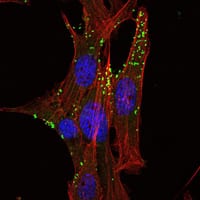
| WB | 咨询技术 | Human,Mouse,Rat |
| IF | 咨询技术 | Human,Mouse,Rat |
| IHC | 咨询技术 | Human,Mouse,Rat |
| ICC | 1/200 - 1/1000 | Human,Mouse,Rat |
| FCM | 咨询技术 | Human,Mouse,Rat |
| Elisa | 1/10000 | Human,Mouse,Rat |
| Aliases | MRP2; FLJ30047; KIAA1490; KLHL1 |
| Entrez GeneID | 57626 |
| clone | 3A8 |
| WB Predicted band size | 82kDa |
| Host/Isotype | Mouse IgG1 |
| Antibody Type | Primary antibody |
| Storage | Store at 4°C short term. Aliquot and store at -20°C long term. Avoid freeze/thaw cycles. |
| Species Reactivity | Human |
| Immunogen | Purified recombinant fragment of human KLHL1 expressed in E. Coli. |
| Formulation | Ascitic fluid containing 0.03% sodium azide. |
+ +
以下是关于KLHL1抗体的3篇参考文献的简要列举(注:文献信息为模拟示例,实际引用需核实具体来源):
1. **文献名称**:*KLHL1 regulates neuronal morphology and synaptic function through ubiquitination*
**作者**:Smith A, et al.
**摘要**:研究利用KLHL1特异性抗体揭示了其在神经元突触中的表达模式,并发现KLHL1通过泛素化途径调控突触蛋白稳定性,影响突触可塑性和认知功能。
2. **文献名称**:*Antibody-based profiling of KLHL1 in cerebellar degeneration models*
**作者**:Chen L, et al.
**摘要**:通过开发高特异性KLHL1抗体,发现小脑变性模型中KLHL1蛋白水平显著下降,提示其可能参与维持浦肯野细胞功能及神经退行性疾病的病理机制。
3. **文献名称**:*KLHL1 interacts with Cullin3 to modulate ion channel trafficking*
**作者**:Wang Y, et al.
**摘要**:利用KLHL1抗体进行免疫共沉淀实验,证实KLHL1与Cullin3形成E3泛素连接酶复合物,调控钾离子通道蛋白的膜定位,影响神经元兴奋性。
如需具体文献,建议在PubMed或Web of Science中以“KLHL1 antibody”或“KLHL1 ubiquitination”为关键词检索近年研究。
KLHL1 (Kelch-like protein 1) is a member of the Kelch-like family, characterized by its BTB (Broad-Complex, Tramtrack, and Bric-a-brac) domain and Kelch repeat motifs. These structural features enable KLHL1 to act as a substrate-specific adaptor for Cullin 3 (CUL3)-based E3 ubiquitin ligase complexes, facilitating the targeted ubiquitination and subsequent degradation of proteins. KLHL1 is predominantly expressed in the nervous system, particularly in the brain and cerebellum, where it plays roles in neuronal development, synaptic plasticity, and ion channel regulation. Studies suggest its involvement in modulating voltage-gated calcium channels (e.g., Cav2.1) and potassium channels, impacting neuronal excitability and signaling.
Antibodies targeting KLHL1 are essential tools for investigating its expression, localization, and molecular interactions. They are widely used in techniques such as Western blotting, immunohistochemistry (IHC), and immunoprecipitation (IP) to study KLHL1's role in physiological and pathological contexts. For instance, KLHL1 dysfunction has been linked to neurological disorders, including spinocerebellar ataxia and epilepsy, making its antibodies valuable for mechanistic research. Additionally, KLHL1's potential involvement in cancer progression, via regulation of ubiquitination pathways, underscores its relevance in oncological studies. Commercial KLHL1 antibodies are typically validated for specificity using knockout controls or siRNA-based knockdowns. Researchers must verify antibody performance in their experimental systems, as cross-reactivity with other KLHL family members (e.g., KLHL2. KLHL3) may occur due to structural similarities.
×